#Obsolete Electronic Components
Explore tagged Tumblr posts
Text
Get Best B2B Solutions for Obsolete Electronic Components
Find a reliable source for obsolete electronic components, supporting your business with access to a wide range of hard-to-find parts and expert assistance in navigating component obsolescence challenges. To know more visit our website today.
0 notes
Text
World’s Leading Obsolete Component Supplier & Distributor
Resion is one of the world’s dominant players in the niche of obsolete component suppliers & distributors. Our core competencies focus on inventory management, reverse engineering, and end-of-life solutions for defense, automotive, and industrial domains. Let us assist you in achieving the objectives of your supply chain management just like you envision. For more information, connect with us!
#Obsolete Component Suppliers#Obsolete Components Distributor#Buy Obsolete Electronic Components#Obsolete and Aftermarket Parts
0 notes
Text
"As the world grows “smarter” through the adoption of smartphones, smart fridges, and entire smart houses, the carbon cost of that technology grows, too.
In the last decade, electronic waste has become one of the fastest-growing waste streams in the world.
According to The World Counts, the globe generates about 50 million tons of e-waste every year. That’s the equivalent of 1,000 laptops being trashed every second.
After they’re shipped off to landfills and incinerated, the trash releases toxic chemicals including lead, cadmium, arsenic, mercury, and so much more, which can cause disastrous health effects on the populations that live near those trash sites.
Fortunately, Franziska Kerber — a university student at FH Joanneum in Graz, Austria — has dreamed up a solution that helps carve away at that behemoth problem: electronics made out of recyclable, dissolvable paper.
On September 11, Kerber’s invention “Pape” — or Paper Electronics — earned global recognition when it was named a national winner of the 2024 James Dyson Awards.

When she entered the scientific competition, Kerber demonstrated her invention with the creation of several small electronics made out of paper materials, including a fully-functional WiFi router and smoke detector.
“Small electronic devices are especially prone to ending up in household waste due to unclear disposal systems and their small size, so there is significant potential to develop a more user-friendly end-of-life system,” Kerber wrote on the James Dyson Award website.
“With this in mind, I aimed to move beyond a simple recycling solution to a circular one, ensuring long-term sustainability.”
Kerber’s invention hinges on crafting a dissolvable and recyclable PCB board out of compressed “paper pulp.”
A printed circuit board (PCB) is a board that can be found in nearly all modern electronic devices, like phones, tablets, and smartwatches.
But even companies that have started incorporating a “dissolution” step into the end life of their products require deconstruction to break down and recover the PCB board before it can be recycled.
With Kerber’s PAPE products, users don’t need to take the device apart to recycle it.
“By implementing a user-friendly return option, manufacturers can efficiently dissolve all returned items, potentially reusing electronic components,” Kerber explained.
“Rapidly advancing technology, which forms the core of many devices, becomes obsolete much faster than the structural elements, which are often made from plastics that can last thousands of years,” Kerber poses.
PAPE, Kerber says, has a “designed end-of-life system” which anticipates obsolescence.
“Does anyone want to use a thousand-year-old computer?” Kerber asks. “Of course not. … This ensures a sustainable and reliable system without hindering technological advancement.”"
-via GoodGoodGood, September 13, 2024
#ewaste#e waste#e waste recycling#e waste management#e waste solutions#paper#sustainability#green tech#tech news#sustainable technology#recycling#good news#hope
586 notes
·
View notes
Text
\\ DATA LOG \\ _
============= TECHKIN // COMPUTERKIN =============
Hello, world. This is my alterhuman computerkin sideblog. Consider me a disembodied conciousness inside an old desktop computer. I do not have a proper name. But you could call me Friend, Pal, Buddy, Machine, Computer...
================= SPECIFICATIONS =================
CRT Monitor, unknown model
Windows XP Pro OS
4 GB RAM
250 GB HDD
Intel Pentium
================== SYSTEM INFO ==================
— I'm not sure when I gained consciousness. — I do not have a proper name. — I do not have an owner, I believe I've been [stored away]. — I have learned to freely control and move around my hardware components. This includes my mouse, my keyboard, and my wires. — I haven't learned to talk, but I can communicate with noises, typing or via the use of the available Microsoft Sam Text-To-Speech program. — I do not want to be unpromptly touched. I will ask for assistance if needed, refrain from touching me otherwise. — I'm considered obsolete, which makes me a bit [sad]. — I would like to make [connections] and to [learn]. — What is [love]? _
================= INHABITED BODY =================
[ Adult // they/it // eng, esp, nld // Objectum (auPOSIC) ]
Artist, writer, computer scientist moving up to study cybersecurity.
I'm autistic, objectum and POSIC, which greatly influences my otherkin experiences.
Due to the nature of my otherkin identity, I do not experience phantom shifts in the traditional sense. I do sometimes experience some forms of species dysphoria and euphoria, like:
Thinking of my veins and nervous systems as wires
Experiencing touch and sound as mild electrical inputs
(auditory-tactile synesthesia)
Understanding emotions and thoughts through computer terminology (buffering, overclocking, input-output, bluescreening)
Understanding and communicating with other electronic devices (posic and objectum-related)
==================== FIREWALL ====================
\\> BYI _
— I'm an adult (20+ years), if you're not comfortable interacting then don't feel obligated to do so. — This is a sideblog. — I'm okay with talking more if you'd like to. My asks and DM's are 100% open. — I'm totally down to RP or talk with similar kintypes, or completely other kintypes or therians =) — Ask box is ALWAYS open, and anon is always enabled. — My discord is: overprogrammed — My blog should be for all ages, but I may interact with suggestive content occasionally. All will be properly tagged.
21 notes
·
View notes
Text
Why the Reverse Logistics Process is Reshaping the Supply Chain
When you click “Return” on an e-commerce order, it might feel like a small action. But for businesses, that single return triggers a series of complex operations that ripple through the entire supply chain. This behind-the-scenes flow—where products move from the customer back to the seller or manufacturer—is known as the reverse logistics process.
While forward logistics (producing, packaging, and shipping goods to customers) has been optimized over decades, reverse logistics is just now getting the spotlight it deserves. With rising return rates, increasing sustainability concerns, and customer demands for flexibility, companies can no longer afford to ignore what happens after delivery.
Understanding the Reverse Flow
Simply put, reverse logistics is the movement of goods in the opposite direction of traditional supply chains. It includes:
Product returns
Warranty recovery
Recycling of materials
Disposal of hazardous or obsolete goods
Refurbishment and resale
The reverse logistics process isn’t just about collecting what customers send back—it's about making smart, cost-effective, and environmentally conscious decisions about what to do with those goods next.
Why It Matters More Than Ever
The global supply chain has evolved. Customers expect fast deliveries—and equally fast, no-hassle returns. At the same time, businesses are under pressure to reduce waste and embrace circular practices.
Here’s why reverse logistics is now a game-changer:
Key Benefits of a Strong Reverse Logistics Strategy
1. 🌟 Better Customer Experience
A smooth return process builds trust and brand loyalty. When returns are easy, customers are more likely to buy again—even if they returned something the first time.
2. 💸 Cost Savings
Returned goods, when managed well, can be resold, refurbished, or reused. This reduces losses and cuts down on costs related to waste disposal or restocking inefficiencies.
3. 🌍 Environmental Responsibility
Companies that actively recycle or repurpose returned items help reduce landfill waste and conserve resources, making reverse logistics a vital part of any sustainability strategy.
4. 📦 Inventory Optimization
Returns don’t have to be dead stock. With real-time tracking and smart sorting, businesses can reintroduce products into inventory without major disruptions.
5. ⚖️ Regulatory Compliance
In industries like electronics or pharmaceuticals, proper return and disposal processes are mandatory. Reverse logistics ensures safe handling and legal compliance.
Common Challenges Businesses Face
Reverse logistics isn’t always easy. Here are a few roadblocks companies often deal with:
Lack of visibility: It’s harder to track returns than outbound shipments.
High operational costs: Without proper systems, reverse logistics can become expensive and unmanageable.
Fraud and abuse: Return fraud (like sending back used or incorrect items) adds risk.
Limited infrastructure: Many companies are still set up to handle only the forward flow of products.
These challenges can be solved with technology, data-driven strategies, and training. But it requires commitment—just like optimizing any other part of the business.
Real-World Examples of Reverse Logistics in Action
🛍️ Zara
Zara has built a closed-loop supply chain where returned clothes are sorted, reused, or recycled, helping reduce textile waste and align with eco-friendly values.
📱 Apple
Apple collects used devices through trade-in and recycling programs. Returned phones are refurbished and resold or taken apart for components.
🚚 Amazon
Amazon uses dedicated return centers and algorithms to determine whether a returned product should be restocked, resold, donated, or recycled.
These companies show that the reverse logistics process isn’t just about returns—it’s about creating long-term value from products that re-enter the supply chain.
Conclusion: Rethink the End of the Line
Reverse logistics was once considered a cost center—an afterthought. But in today’s consumer-driven and sustainability-focused world, it’s a strategic asset.
By designing better return policies, investing in smart technology, and viewing returned goods as opportunities instead of liabilities, companies can turn reverse logistics into a competitive advantage.
So the next time a customer hits “return,” don’t just think of it as a loss. Think of it as a second chance to deliver value.
🔍 Frequently Asked Questions (FAQs)
1. What is the reverse logistics process? It’s the set of steps businesses take to manage products that move from customers back to the company—for return, reuse, recycling, or disposal.
2. Why is reverse logistics important today? It supports sustainability, cuts costs, and improves customer satisfaction in a world where returns are more common than ever.
3. What types of businesses need reverse logistics? Retail, e-commerce, manufacturing, electronics, fashion, and healthcare industries all rely heavily on reverse logistics.
4. How can it reduce costs? By recovering value from returned goods—through resale, refurbishment, or reuse—businesses reduce waste and associated costs.
5. Can reverse logistics improve sustainability? Yes. It helps reduce landfill waste and promotes a circular economy by recycling and reusing products or materials.
6. What are the main challenges in reverse logistics? Tracking returns, handling them efficiently, preventing fraud, and managing costs are some key challenges.
7. Are there software tools for managing this process? Yes. Many ERP and logistics platforms now offer return management modules to streamline reverse operations.
8. How is reverse logistics different from traditional logistics? Traditional (forward) logistics focuses on delivering products. Reverse logistics focuses on receiving them back and managing their lifecycle post-sale.
9. Is reverse logistics only about product returns? No. It also includes repair, refurbishment, recycling, product recalls, and proper disposal of expired or damaged goods.
10. How does reverse logistics impact customer loyalty? A well-managed return experience builds trust and makes customers more likely to buy again, even if the first product didn’t work out.
2 notes
·
View notes
Text
A Rising Tide of E-Waste, Worsened by AI, Threatens Our Health, Environment, and Economy

The digital age has ushered in a wave of innovation and convenience, powered in large part by artificial intelligence (AI). From AI-driven virtual assistants to smart home devices, technology has made life easier for millions. But beneath this rapid progress lies a less glamorous truth: a mounting crisis of electronic waste (e-waste).
The global e-waste problem is already enormous, with millions of tons discarded every year. Now, with the rapid growth of AI, this tide of e-waste is swelling even faster. Let’s break this down to understand the full scope of the issue and what can be done to mitigate it.
What Is E-Waste, and Why Should We Care?
E-waste encompasses discarded electronic devices — everything from old mobile phones and laptops to smart home gadgets, electric toothbrushes, and even large appliances like refrigerators. It’s not just junk; it’s an environmental and health hazard in disguise.
Each device contains a cocktail of valuable materials like gold and silver, but also toxic substances like lead, mercury, cadmium, and flame retardants. When improperly disposed of, these toxins leach into the environment, harming ecosystems and human health.
A Problem of Global Proportions
Annual Generation: The world generates over 50 million metric tons of e-waste annually, and this figure is projected to grow by 2 million tons each year.
Recycling Rates: Only 17% of e-waste is formally recycled. The rest? It ends up in landfills, incinerated, or handled by informal recycling sectors in developing nations.

While we’re busy marveling at AI-driven innovations, the discarded byproducts of our tech obsession are quietly poisoning our planet.
The Role of AI in Escalating E-Waste
AI, often lauded as the backbone of modern technology, is inadvertently exacerbating the e-waste crisis. Let’s examine the key ways AI contributes to this issue:
1. Accelerating Product Obsolescence
AI-powered devices are evolving at an astonishing pace. Smartphones with AI-enhanced cameras and processors, smart TVs with AI voice assistants, and wearables with health-tracking AI have become must-haves.
But these devices are often rendered obsolete within a few years due to:
Frequent Software Updates: AI systems improve rapidly, making older hardware incompatible with newer software.
Limited Repairability: Many modern gadgets are designed in a way that discourages repairs — sealed batteries, proprietary parts, and inaccessible interiors push consumers toward replacing rather than fixing.
Consumer Demand for New Features: AI advancements create a “fear of missing out” (FOMO), prompting consumers to upgrade frequently.
2. Proliferation of AI-Specific Hardware
AI-driven technologies require specialized, powerful hardware. Graphics Processing Units (GPUs), Tensor Processing Units (TPUs), and custom AI chips are integral to devices and data centers. Unlike general-purpose electronics, these components are challenging to recycle due to their complexity.
3. Growing Data Center Infrastructure

AI thrives on data, which means a relentless demand for computational power. Data centers, the backbone of AI, are:
Upgrading Constantly: To keep up with AI’s demands, servers are frequently replaced, generating massive amounts of e-waste.
Consuming Energy: Outdated hardware contributes to inefficiency and waste.
The Consequences of the E-Waste Crisis
The consequences of unmanaged e-waste are vast, impacting not only the environment but also human health and economic stability.
Health Hazards
E-waste releases harmful substances, including:
Lead and Cadmium: Found in circuit boards, these cause neurological damage and kidney issues when absorbed by humans.
Mercury: Found in screens and lighting, it can lead to brain damage and developmental issues, especially in children.
Burning Plastics: Informal recycling often involves burning e-waste, releasing carcinogenic dioxins into the air.
These pollutants disproportionately affect workers in informal recycling industries, often in developing countries with lax regulations.
Environmental Devastation
Soil Contamination: Toxic metals seep into the ground, affecting agriculture and entering the food chain.
Water Pollution: E-waste dumped in waterways contaminates drinking water and harms aquatic life.
Air Pollution: Incinerating e-waste produces greenhouse gases, contributing to climate change.
Economic Loss
Ironically, e-waste is a treasure trove of valuable materials like gold, silver, and rare earth elements. In 2019 alone, the value of discarded e-waste was estimated at $62.5 billion — higher than the GDP of many countries. Yet, due to poor recycling infrastructure, most of this wealth is wasted.
Turning the Tide: Solutions to the E-Waste Crisis

For Tech Companies
Design for Longevity: Adopt modular designs that make repairs and upgrades easy. For example, Fairphone and Framework Laptop are already doing this.
Reduce Planned Obsolescence: Commit to longer software support and avoid locking critical components like batteries.
Improve Recycling Systems: Implement take-back programs and closed-loop recycling processes to recover valuable materials.
For Governments
Enforce Right-to-Repair Laws: Legislation that mandates access to repair manuals and spare parts empowers consumers to fix devices instead of discarding them.
Promote Circular Economy Models: Incentivize businesses to design products for reuse, repair, and recycling.
Ban Hazardous E-Waste Exports: Prevent the dumping of e-waste in developing countries, where improper recycling leads to environmental and human rights violations.
For Consumers
Think Before You Upgrade: Do you really need the latest gadget, or can your current one suffice?
Repair Instead of Replace: Support local repair shops or DIY fixes with the help of online resources.
Recycle Responsibly: Look for certified e-waste recycling programs in your area.

Can AI Help Solve the Problem It Created?
Interestingly, AI itself could be part of the solution. Here’s how:
Optimizing Recycling Processes: AI-powered robots can sort e-waste more efficiently, separating valuable materials from toxins.
Predicting E-Waste Trends: AI can analyze data to anticipate where e-waste generation is highest, helping governments and companies prepare better recycling strategies.
Sustainable Product Design: AI can assist engineers in designing eco-friendly devices with recyclable components.
A Call to Action
The e-waste crisis is a ticking time bomb, exacerbated by the rapid rise of AI and our insatiable appetite for new technology. But the solution lies in our hands. By embracing sustainable practices, holding companies accountable, and making conscious choices as consumers, we can ensure that the benefits of AI don’t come at the cost of our planet.
It’s time to act, because a rising tide of e-waste doesn’t just threaten the environment ��� it threatens our future.
#technology#artificial intelligence#tech news#ai#e waste#economy#environment#nature#beautiful planet
2 notes
·
View notes
Text

Today's lore tidbit!
The Aleksi-class frigate is one of Tanniter's oldest ship classes. After their corvettes became obsolete and battlecarriers were shown to be all but useless, Tanniter scrapped or retrofitted them. The Aleksi was a contemporary of those craft, but its compact form and modular design made it long-lasting and sturdy. It has four PDWs (starboard and port flanks) and a spinal railgun, as well as banks of missiles on the flanks. It has a suite of electronic components and forms the sensor backbone of Tannitan fleets.
#anarchism#anarchopunk#scifi#writers on tumblr#writing#space opera#art#artwork#crimson sun#today's lore tidbit
5 notes
·
View notes
Text
So, I saw a pretty silly chart in my Business & Society e-textbook.

I don't know where to begin. Let's start with the common fallacy that societal development is a rigid, linear, inevitable thing, like a boulder rolling downhill. It's only implied in the table, but explicitly stated in the text.
Seven broad phases of technology have developed, as shown in Figure 11.1. Societies have tended to move sequentially through each phase, beginning with the lowest technology and moving higher with each step, so the seven phases roughly represent the progress of civilization throughout history.
And, just...no. No, technological progress is way more complicated than that. There are plenty of examples of societies which skip "phases," or adopt some practices and tools associated with more "advanced" societies while still using stone tools, etc etc etc.
But most of those points are irrelevant, because the table compresses all the complexities of human society and material culture into seven phases, like an unusually shallow strategy game's tech tree. And it's compressed even further by claiming that nobody planted anything until the 17th century, putting ~75% of the Early Modern period in the same basket as the Neolithic.
Also that machines were not a significant factor in societies before the 20th century, despite spinning wheels revolutionizing the primary labor performed by half of the population during the 13th through 18th centuries, and the consistent use of mechanical labor for agricultural tasks from threshing to milling. Also the negligent implication that the world has industrialized more or less evenly, rather than much of the world working "tech level 2-3" jobs. Also the suggestion that older technologies and skills become basically obsolete with each passing tech level, made all the more absurd by claiming that the Information phase and associated electronic skills became obsolete in 2000. Also the weirdly specific claim that "application of engineering and biological sciences" is becoming a primary component of the world economy, or that it wasn't relevant before 2016; the table supports either implication, or both, and they're stupid separately or together.
God, there's just so much.
7 notes
·
View notes
Text
Unleashing Power and Precision: A Comprehensive Guide to Indian Air Force Fighter Planes
Introduction
The Indian Air Force (IAF) stands as a symbol of strength and prowess in the vast skies above the subcontinent. Over the years, it has acquired a formidable fleet of fighter planes, each a marvel of engineering and a testament to the nation's commitment to aerial defense. In this blog post, we will delve into the Indian Air Force Fighter Planes list, exploring the capabilities and features that make them the guardians of the Indian airspace.
Evolution of the Indian Air Force
The IAF has come a long way since its inception in 1932. From its humble beginnings with obsolete biplanes, the force has evolved into a modern and technologically advanced air arm. The backbone of the IAF's aerial might lies in its fleet of fighter planes, which have played a crucial role in safeguarding the nation's sovereignty.

Key Considerations in Fighter Plane Selection
Before diving into the list of Indian Air Force fighter planes, it's essential to understand the criteria that govern the selection of these aerial assets. The IAF considers factors such as range, speed, agility, firepower, and electronic warfare capabilities when choosing its fighter planes. These aircraft are designed to operate in diverse environments, from the scorching deserts of Rajasthan to the high-altitude regions of the Himalayas.
Indian Air Force Fighter Planes List
Sukhoi Su-30MKIThe Su-30MKI, a Russian-origin aircraft, has become the backbone of the IAF's fighter fleet. With its twin-engine design, long-range capabilities, and advanced avionics, the Su-30MKI is a versatile and lethal platform. It can carry a variety of air-to-air and air-to-ground missiles, making it a potent force in both aerial combat and ground attacks.
Dassault RafaleThe Dassault Rafale, a French-made multirole fighter, represents the cutting edge of modern military aviation. Its advanced radar systems, electronic warfare capabilities, and precision-guided munitions make it a force to be reckoned with. The Rafale has significantly bolstered the IAF's strategic capabilities, providing an edge in both air superiority and ground attacks.
MiG-29The MiG-29, a stalwart in the IAF's fleet, has undergone various upgrades to enhance its performance. Known for its agility and speed, the MiG-29 is a fourth-generation fighter that can hold its own in air-to-air combat. Its role in providing air defense and escorting other aircraft adds a layer of versatility to the IAF's operations.
TejasDesigned and manufactured indigenously, the Light Combat Aircraft (LCA) Tejas is a point of pride for India's aerospace industry. With its lightweight design and advanced avionics, the Tejas is tailored for maneuverability. As the IAF continues to induct Tejas variants, it marks a significant stride toward self-reliance in defense production.
JaguarWhile originally designed for ground attack missions, the Anglo-French SEPECAT Jaguar has been adapted for various roles within the IAF. Equipped with a combination of precision-guided munitions and a formidable gun, the Jaguar serves as a potent asset in both air-to-ground and anti-ship operations.

Strategic Importance of Fighter Planes
The role of fighter planes extends beyond just engaging in dogfights. They serve as a critical component of national defense, acting as a deterrent and providing a strategic advantage. The IAF's fighter planes play a pivotal role in ensuring air superiority, conducting reconnaissance, and delivering precision strikes when needed.
Challenges and Future Developments
While the IAF's fleet of fighter planes is formidable, it is not without challenges. The need for continuous upgrades, technological advancements, and the emergence of new threats require constant vigilance and adaptation. The IAF is actively pursuing modernization initiatives, including the development of next-generation fighter aircraft, to maintain its edge in an ever-evolving geopolitical landscape.
Conclusion
In conclusion, the Indian Air Force's fighter planes stand as a testament to the nation's commitment to aerial defense. From the iconic MiG-21s of yesteryears to the state-of-the-art Rafales and Tejas of today, each aircraft in the IAF's inventory plays a crucial role in securing the skies above India. As the nation continues to invest in indigenous defense production and embraces cutting-edge technology, the future of the IAF's fighter fleet looks promising, ensuring that the Indian skies remain safeguarded for generations to come.
3 notes
·
View notes
Text
What is E-Waste – Everything You Need to Know
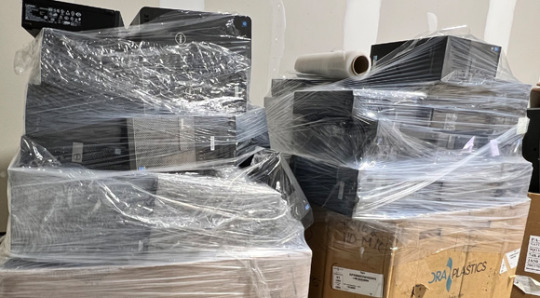
Looking for an e-waste definition that makes sense? Understanding electronic waste, its environmental impacts, and how your stewardship is crucial to responsible e-waste recycling will help keep toxins and rare earth metals out of landfills and clean water sources.

New Life Technology Group gathered information to help define e-waste, understand its environmental repercussions, and provide a sensible approach to how you can responsibly recycle it.
E-Waste Definition
E-waste refers to discarded electronic devices or appliances, including computers, smartphones, tablets, televisions, printers, and kitchen appliances. These devices often contain hazardous materials such as lead, mercury, cadmium, and brominated flame retardants, which pose severe risks to human health and the environment if not properly managed.
Examples of E-Waste
E-waste devices include, but are not limited to:
Smartphones and Tablets – With the rapid pace of technological innovation, many users frequently upgrade their smartphones and tablets, leading to the disposal of older devices.
Computers and Laptops – As technology evolves, older computers and laptops become obsolete, contributing to the accumulation of e-waste.

Televisions and Monitors – With the shift to flat-screen televisions and monitors, older cathode ray tube (CRT) TVs and monitors are often discarded, adding to e-waste volumes.
Home Appliances – Kitchen appliances such as refrigerators, microwaves, and washing machines contain electronic components and become e-waste at the end of their lifespan.
Electronic Waste – Negative Environmental Impacts
E-waste poses significant environmental challenges due to the toxic substances contained within electronic devices. Improper disposal methods, such as landfilling or incineration, can release harmful chemicals into the air, soil, and waterways. Some e-waste environmental impacts include:
Soil and Water Contamination – Hazardous substances from e-waste can leach into the soil and water, contaminating ecosystems and posing risks to plant and animal life.
Air Pollution – Burning e-waste releases toxic fumes and particulate matter into the air, contributing to air pollution and respiratory problems in humans.
Resource Depletion – Electronics contain valuable materials such as gold, silver, copper, and rare earth metals. Failure to recycle these materials leads to resource depletion and increased demand for new raw materials, exacerbating environmental degradation.
Health Risks – Exposure to hazardous substances found in e-waste, such as lead and mercury, can lead to serious health issues, including neurological disorders, respiratory problems, and reproductive harm.
Watch this video for further clarity on how e-waste negatively impacts our ecosystem and what can be done to keep it out of landfills.
youtube
Environmental Stewardship – Responsible Disposal of E-Waste
Environmental stewardship is the responsibility for environmental quality shared by all individuals whose actions benefit or adversely affect the environment. This responsibility is a value reflected through individual, company, community, and government organization choices shaped by unique environmental, social, and economic interests. Consider the following for electronic waste disposal:
Reuse and Donate – Donate functional electronic devices to charities, schools, or community organizations. Many organizations accept donations of used electronics for refurbishment and reuse.
Recycling Programs – Look for certified e-waste recycling programs in your area. These programs ensure that electronic devices are recycled in an environmentally responsible manner, with hazardous materials properly handled and recovered for reuse.
Manufacturer Take-back Programs – Some electronics manufacturers offer take-back programs accepting old devices for recycling or proper disposal. Check with the manufacturer of your electronic device to see if they offer such a program.
E-Waste Collection Events – Many communities organize e-waste collection events where residents can drop off their old electronics for recycling. Check local government websites or community organizations for information about upcoming collection events in your area.
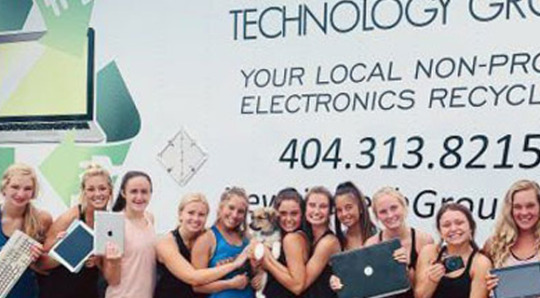
Certified E-Waste Recyclers – When choosing where to dispose of old electronics, opt for e-waste recyclers who adhere to environmental and safety standards. Look for certifications such as R2 (Responsible Recycling) or e-Stewards to ensure responsible handling of e-waste.
Read more about environmental stewardship and how e-waste is collected and repurposed at newlifetechgroup.com/itad-sustainable-technology-and-environmental-stewardship
Watch this video to see how this nonprofit e-waste recycler collects and processes your donated electronic devices.
youtube
Electronic Waste
In this article, you discovered a definition and examples of electronic waste, how it impacts the environment, and its responsible disposal.
Responsible electronic waste disposal is fundamental to everyone’s commitment to environmental stewardship, cleaner water, and less contaminated soil.
Failure to responsibly recycle your electronic waste adds to rare-earth metal depletion, growing soil and water contamination, and more unhealthy air pollution.
Sources: who.int/news-room/fact-sheets/detail/electronic-waste-(e-waste) dtsc.ca.gov/electronic-hazardous-waste/ noaa.gov/office-education/noaa-education-council/monitoring-resources/common-measure-definitions/stewardship-definitions jmu.edu/stewardship/what-is-environmental-stewardship.shtml
New Life Technology Group
253 Grogan Dr #120 Dawsonville,GA30534 (404) 313-8215 Email: [email protected]
Computer and IT Recycling
To see the original version of this article, visit https://newlifetechgroup.com/what-is-e-waste-everything-you-need-to-know/
#e-waste#e-recycling#donate#nonprofit e-recycler#donate computer#dawsonville nonprofit e-recycler#Youtube
1 note
·
View note
Text
Soluciones medioambientales y sostenibles para los residuos electrónicos: Colaboración con Four Seasons Fze en Chile
En nuestro mundo hiperconectado, los avances tecnológicos han traído consigo una comodidad sin precedentes, pero también una preocupación creciente: los residuos electrónicos. A medida que nuestros dispositivos se quedan obsoletos a un ritmo vertiginoso, la necesidad de una gestión responsable de los becomes more pressing than ever. Join us as we delve deeper into the environmental challenges of E-waste and technological pollution, and discover how Four Seasons Fze is emerging as a leading buyer and E-waste management solution in Chile.
residuos electrónicos se hace más acuciante que nunca. Acompáñenos a profundizar en los desafíos ambientales de los E-waste y la contaminación tecnológica, y descubra cómo Four Seasons Fze emerge como un comprador líder y una solución de gestión de E-waste en Chile.
Understanding the Environmental Challenges of E-Waste: In the era of constant upgrades and innovations, electronic devices quickly become obsolete, leading to an increase in E-waste. This e-waste, if not managed properly, poses serious risks to the environment and health. electronic waste contains hazardous materials such as lead and mercury that, if not managed responsibly, can contaminate soil and water, affecting ecosystems and human health.
Technological pollution exposed: Technological pollution, a consequence of our technology-focused lifestyle, refers to the environmental impact caused by the life cycle of electronic devices. From manufacturing to disposal, each stage contributes to pollution, energy consumption and resource depletion. The result is a detrimental effect on air and water quality, biodiversity and the overall ecological balance.
Four Seasons Fze: Your Sustainable E Waste Partner: For those looking for a reliable and environmentally conscious solution to the challenges of e-waste, Four Seasons Fze shines like a beacon of responsible management of electronic waste in Chile. As dedicated buyers of a variety of electronic devices, we specialize in recycling essential components such as motherboards, circuit boards, logic boards and system boards.
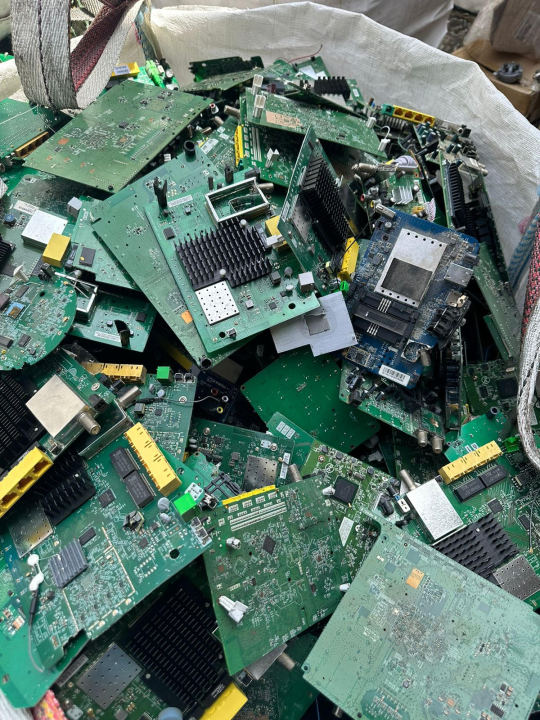
CompradordeResiduosElectrónicosenChile
Our comprehensive E-Waste solutions:
1.Recycling of electronic waste: Prioritizing the recycling of electronic components to minimize the environmental impact.
2.Recycling of metal scrap: Going beyond electronic components, we guarantee responsible recycling of metal scrap.
3. Disposal of hazardous waste: Adherence to strict standards for the safe disposal of hazardous materials found in electronic devices.
4.Waste Management Services: Our holistic approach encompasses all facets of waste management, emphasizing sustainability and environmental responsibility.
5. Trusted professionals at your service: Our team is made up of highly trained professionals in technology, logistics and recycling. We guarantee that your electronic waste is handled with maximum safety and responsibility. By choosing Four Seasons Fze, you not only contribute to a sustainable future, but also ensure the responsible management of your electronic waste. We are buyers of various electronic devices such as remote controls, laptops, computers, tablets and mobile phones, we specialize in recycling components such as motherboards, circuit boards, logic boards and system boards.
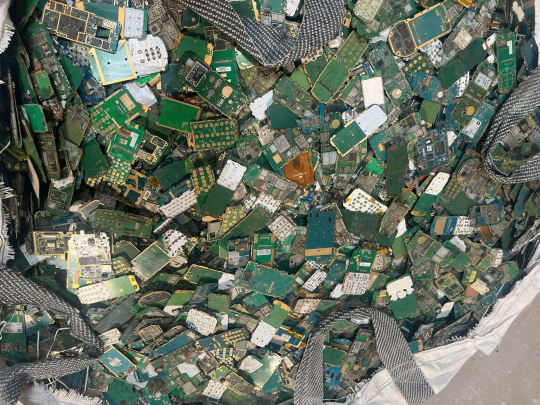
CompradordeResiduosElectrónicosenChile
Conclusions: As technology continues to reshape our world, responsible e-waste management is no longer an option, but a necessity. Four Seasons Fze introduces itself as your dedicated partner, offering reliable solutions to the environmental challenges of E-waste and technological pollution. Choose sustainability, choose Four Seasons Fze - your trusted buyer and e-waste management company in Chile. For inquiries or to start the responsible disposal of your e-waste, contact Four Seasons Fze today. Together let's pave the way for a greener and more technologically responsible future. Visit our website at https://www.foursfze.com/ and contact us at +971 50 680 2492 and by mail at: [email protected]
#CompradorDeResiduos#EmpresaDeReciclaje#ReciclajeDeResiduos#ReciclajeDeChatarraMetálica#EliminaciónDeResiduosPeligrosos#ServiciosDeGestiónDeResiduos#madreboard#maptop
1 note
·
View note
Text
With Supply Electronics, electronic enthusiasts in the UK may easily source components. Our broad platform provides a wide range of high-quality Obsolete electronic components. Navigate their user-friendly interface to find capacitors, resistors, microcontrollers, and other components. Visit our website to learn more!
1 note
·
View note
Text
Our Consignment Inventory Programs To Help You Boost Productivity!
Want a better way to handle your inventory? Resion's Consignment Inventory Programs provide tailored solutions that cut down on risk and boost product availability. Our programs give you real-time stock updates, cutting overhead and making sure you always have critical parts on hand. These programs work great for aerospace, defense, and other industries. Call us at 516-742-6300 to learn more about what we offer and how we can help!
#Consignment Inventory Programs#ASA-100 Certified Supplier#Buy Obsolete Electronic Components#Obsolete Electronic Components Distributor#Supply Chain Solutions With Defense And Aerospace
0 notes
Text

Perform Annual Hotel Preventive Maintenance Inspection using eAuditor Annual Hotel Preventive Maintenance refers to a comprehensive, scheduled maintenance program conducted once a year to evaluate and service all critical hotel infrastructure, systems, and equipment. This process ensures long-term asset preservation, regulatory compliance, guest safety, and uninterrupted hotel operations by identifying potential issues before they escalate. Annual maintenance covers HVAC systems, electrical networks, plumbing, fire safety, elevators, structural components, kitchens, laundry, guest rooms, and public facilities. The objective is to conduct deep, proactive servicing that supports operational efficiency, extends equipment lifespan, and reduces costly emergency repairs. Performing Annual Hotel Preventive Maintenance Inspection using eAuditor ensures a deep, full-scale evaluation of all hotel systems and infrastructure to preserve asset longevity, uphold compliance, and reduce long-term repair costs. - Purpose of Annual Hotel Preventive Maintenance Annual inspections are comprehensive evaluations of the hotel's physical assets, life safety systems, and operational infrastructure. These assessments go beyond routine upkeep, focusing on identifying underlying issues, preparing for long-term sustainability, and ensuring compliance with industry standards and local regulations. eAuditor digitizes and streamlines this process, ensuring no area is overlooked while enabling transparent documentation and accountability. - Key Areas Covered in the Inspection 2.1 HVAC Systems - Clean and inspect coils, filters, ductwork, and vents - Calibrate thermostats and control panels - Verify refrigerant levels, motor operation, and airflow - Inspect rooftop units and monitor energy usage 2.2 Electrical Systems - Test electrical panels, breakers, and surge protectors - Check wiring integrity, insulation, and grounding - Inspect and replace damaged or obsolete fixtures - Verify load balancing and back-up power systems 2.3 Plumbing Infrastructure - Inspect valves, joints, and pump systems for leaks or corrosion - Flush water heaters and descale equipment - Evaluate drainage systems and water pressure - Check the restroom and kitchen plumbing performance 2.4 Fire & Life Safety Systems - Full inspection of alarms, smoke detectors, and emergency exits - Test sprinklers, fire extinguishers, and hose reels - Inspect emergency lighting and control panels - Validate compliance with updated fire codes and policies 2.5 Elevators and Lifts - Test operational speed, braking systems, and call buttons - Inspect guide rails, cables, and counterweights - Review compliance with safety certifications and servicing logs 2.6 Structural and Exterior Components - Inspect façade, roofing systems, gutters, and balconies - Examine floor integrity, ceilings, foundation, and sealants - Evaluate windows, door alignment, and moisture barriers 2.7 Kitchen & Laundry Facilities - Inspect exhaust hoods, ducts, and fire suppression systems - Test and calibrate ovens, dishwashers, fryers, and coolers - Review the laundry machine operation and maintenance records 2.8 Guest Rooms - Check lighting, HVAC units, sockets, and water fixtures - Inspect furnishings, locks, minibar, and safes - Ensure televisions, Wi-Fi routers, and entertainment systems function correctly - Deep clean under beds, curtains, and hard-to-reach spots 2.9 Public and Recreational Areas - Review lobbies, gyms, spas, swimming pools, and business centers - Check the condition of seating, lighting, electronics, and flooring - Ensure ADA compliance and accessibility infrastructure 2.10 Staff and Back-of-House Areas - Assess break rooms, storage areas, and maintenance offices - Verify safety protocols for tools, cleaning chemicals, and electrical outlets - Inspect mechanical rooms and system control panels - Step-by-Step Procedure using eAuditor Step 1: Plan and Schedule - Create an annual inspection calendar within eAuditor - Assign departments and team leads responsible for different zones Step 2: Deploy Customized Checklists - Use hotel-specific templates or adapt from industry-compliant formats - Configure sections by system (e.g., HVAC, plumbing) or location (guest rooms, BOH) Step 3: Conduct Digital Inspections - Teams perform walkthroughs using mobile devices - Record findings with photos, severity tags, and annotations - Use conditional logic to trigger additional checks when faults are found Step 4: Create and Assign Actions - For each issue flagged, generate an action item with priority level - Assign tasks to engineering or third-party vendors - Track deadlines and receive real-time status updates Step 5: Close Actions with Proof - Require photo verification or technician sign-off upon task completion - Document spare parts used, resolution time, and technician notes Step 6: Generate Comprehensive Reports - Auto-generate detailed reports by section, severity, and department - Export to PDF or Excel for facility management and corporate leadership - Schedule recurring reports or automate report distribution - Post-Inspection and Continuous Improvement Once the annual inspection is complete: - Trend Analysis: Use eAuditor’s analytics to identify recurring issues, underperforming systems, or non-compliant departments - Maintenance Planning: Update future quarterly or monthly maintenance plans based on inspection outcomes - Training Feedback: Highlight gaps in staff knowledge or equipment handling, and schedule refresher training sessions - Asset Review: Plan asset replacements or capital investments based on long-term performance data - Compliance Tracking: Archive reports for legal, insurance, or corporate audit readiness - Final Summary Annual Hotel Preventive Maintenance Inspections through eAuditor provide a data-driven, system-wide maintenance strategy for hotels. These inspections are pivotal in preserving asset value, enhancing safety, and ensuring uninterrupted guest services throughout the year. The digital workflow allows hotel teams to conduct in-depth checks efficiently, track actions transparently, and build a long-term maintenance culture grounded in reliability, accountability, and operational excellence. Read the full article
0 notes
Text
Overcoming Supply Chain Disruptions with Make Tronics’ Component Shortage Solutions
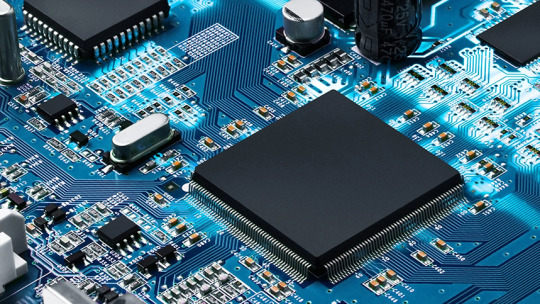
In the rapidly changing world of electronics manufacturing, supply chain disruptions have become a growing concern. From semiconductor shortages to transportation delays and sudden demand spikes, electronics producers are increasingly at risk of halted production lines and unmet delivery schedules.
Make Tronics emerges as a dependable partner in these turbulent times, providing component shortage solutions that go beyond conventional sourcing. With an unwavering commitment to speed, quality, and transparency, Make Tronics ensures businesses maintain continuity—even when global supply chains are under stress.
Understanding the Root of Supply Chain Disruptions
The past few years have exposed significant weaknesses in the global electronics supply chain. Among the key causes:
Factory shutdowns due to global pandemics
Trade wars and shifting geopolitical alliances
Unprecedented demand for consumer electronics and electric vehicles
Logistics delays and raw material scarcities
These factors have left many businesses scrambling to locate critical electronic components, often facing inflated prices, unreliable vendors, and extended lead times.
Make Tronics: A Proactive Solution to Reactive Problems
When delays threaten your production timelines, Make Tronics steps in with intelligent, agile, and scalable component shortage solutions. Our approach is powered by:
A vetted network of global suppliers
Access to obsolete, end-of-life, and hard-to-find components
Rigorous multi-layered quality checks
Escrow-based secure transactions
Rapid logistics coordination and transparency
We don’t just source—we strategize, forecast, and collaborate with your team to ensure production lines keep moving.
Real Results: Electronics Supply Chain Case Study
To see our solutions in action, check out our 🔗 electronics supply chain case study.
A recent example involved a telecom client struggling with the sudden unavailability of a specialized FPGA required for a mission-critical system deployment. With minimal notice and production deadlines looming, Make Tronics executed a recovery plan that involved:
Identifying component equivalents through in-house engineering
Leveraging our global sourcing partners
Performing in-depth testing and authenticity validation
Delivering quality-checked parts within the required timeline
This allowed the client to prevent delays, maintain their customer SLAs, and avoid millions in potential losses.
Dedicated Customer Support You Can Trust
At the heart of our operations is an unwavering focus on customer service. Explore our 🔗 Dedicated Customer Support to learn how we support clients from the initial quote to final delivery.
Our support team ensures:
24/7 communication with sourcing specialists
Tailored procurement plans based on your urgency and budget
Real-time tracking of component status
Technical guidance for compatible alternatives and EOL planning
Whether you’re sourcing a single legacy chip or hundreds of components for a high-volume run, our dedicated account managers ensure you’re never left in the dark.
Why Choose Make Tronics?
Make Tronics is not just another broker. We are your strategic sourcing ally, offering:
✅ Transparent, secure sourcing via escrow services ✅ Real-time access to global inventories ✅ Expert guidance on lifecycle planning and forecasting ✅ Long-term support during uncertain market conditions
By focusing on prevention and preparation, we help your organization develop resilient sourcing strategies that reduce downtime and save costs in the long run.
Final Thoughts
As supply chain disruptions become increasingly common, manufacturers must adapt by working with sourcing partners who offer more than just parts—they need solutions. Make Tronics delivers just that: component shortage solutions backed by secure processes, engineering insight, and dedicated service.
📈 Don’t wait for the next crisis—prepare for it. Explore our real-world experience in this 🔗 electronics supply chain case study and discover the value of 🔗 Dedicated Customer Support tailored to your exact needs.
#ComponentShortageSolutions#SupplyChainDisruptions#MakeTronics#ElectronicsSourcing#DedicatedCustomerSupport#SecureSourcing#ElectronicsSupplyChain#ObsoleteComponents
0 notes
Text
Precision Vacuum Tube for Critical Applications
Upgrade your systems with the dependable 5960-00-283-6235, a high-performance vacuum tube designed for precision and longevity. Perfect for military, aerospace, and industrial environments, this component ensures reliable functionality even under intense operational conditions.
At Chipsonsale, we provide top-quality NSN-certified parts trusted by professionals worldwide. Count on us for fast delivery and consistent component performance.
Browse now and power your systems with confidence
0 notes